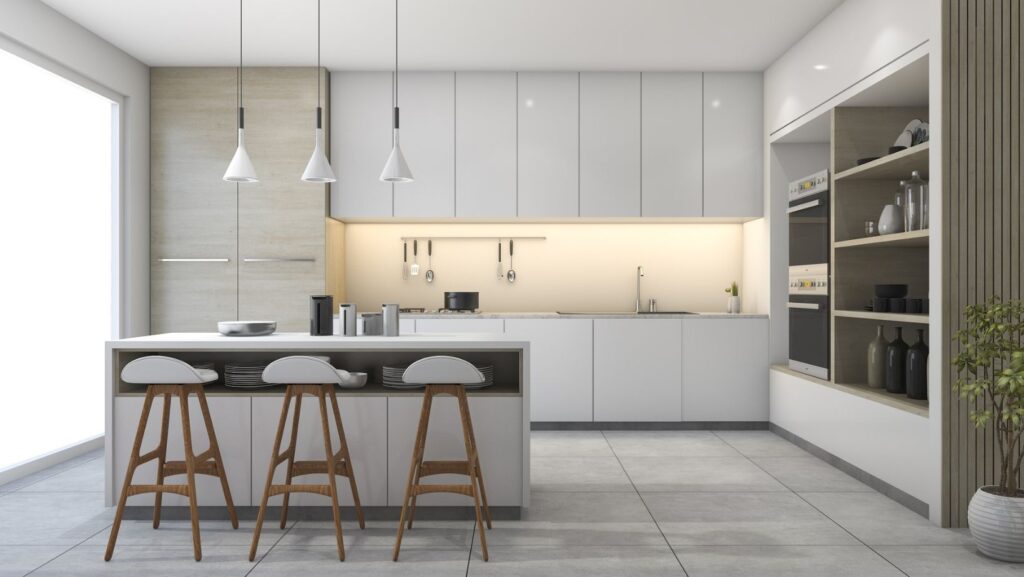The kitchen frequently earns its reputation as the central hub of a household, and this status is well-deserved. It serves as the place where we nourish ourselves, explore culinary creations, and come together with loved ones. The significance of establishing an effective kitchen layout cannot be overstated, as it transforms this area into not just a functional space but also an enjoyable one to operate within. Whether you find yourself embarking on a kitchen design from the ground up or revitalizing an already existing one, this guide offers comprehensive insights to assist you in attaining a well-structured and highly organized kitchen layout.
- Assess Your Space
Before diving into any design decisions, take a good look at your kitchen space. Note the dimensions, existing features, and any structural constraints, such as windows, doors, and electrical outlets. Understanding your space’s limitations and possibilities is the first step toward crafting an efficient layout.
- Identify the Work Triangle
The work triangle is a fundamental concept in kitchen design, consisting of three key work zones: the cooking area (stove and oven), the cleaning area (sink and dishwasher), and the storage/prep area (refrigerator and countertop). These zones should form a triangle, allowing for efficient movement between them. Aim to keep the total distance of the triangle between 12 and 26 feet to minimize unnecessary steps.
- Plan for Adequate Counter Space
Countertop space is precious in the kitchen. Ensure you have ample room for food preparation, placing appliances, and setting out dishes. Consider adding a kitchen island if space allows, as it can serve as both extra workspace and a gathering spot for family and guests.
Read more.. Luxury Vinyl Tile (LVT) Versus Laminate Flooring: A Comparative Guide
- Optimize Storage
Efficient storage is the key to keeping your kitchen organized. Invest in quality cabinetry and drawer systems that maximize space utilization. Utilize deep drawers for pots and pans, pull-out pantry shelves for easy access to dry goods, and consider specialized storage solutions for items like spices, utensils, and baking sheets.
- Choose the Right Appliances
Select appliances that effortlessly blend into your kitchen’s aesthetic. Opting for energy-efficient models not only promises sustainable cost savings but also plays a role in promoting a more eco-friendly environment. Ensure the strategic placement of your appliances, with the refrigerator thoughtfully located near the entrance for convenient access and the dishwasher positioned close to the sink, streamlining post-meal cleanup.
- Lighting Matters
Good lighting is essential for both functionality and aesthetics. A combination of ambient, task, and accent lighting can create a well-lit kitchen. Install under-cabinet lighting to illuminate countertops, pendant lights above the island or dining area, and recessed lighting for general brightness.
- Consider Flow and Traffic
Think about the flow of movement in your kitchen. Avoid placing obstacles or tight spaces between key work areas. Ensure there’s enough clearance for cabinet and appliance doors to open fully without blocking pathways. Designate a clear traffic path to prevent congestion, especially in busy kitchens.
Read more.. Unveiling the Charm: Embarking on a Journey into Eclectic Interior Design
- Personalize Your Design
Your kitchen should reflect your personal style and cooking habits. Consider the layout that best suits your needs, whether it’s an open concept kitchen, a U-shaped design, or a galley kitchen. Select materials, colors, and finishes that resonate with your aesthetic preferences and complement the overall design of your home.
- Ventilation Matters
Proper ventilation is crucial to maintaining a healthy kitchen environment. Install a range hood or exhaust fan to remove cooking odors, grease, and moisture. This not only contributes to a more comfortable kitchen but also helps preserve the quality of your indoor air.
- Test Your Design
Before finalizing your kitchen layout, create a mockup or use design software to visualize the space. Walk through the motions of cooking, cleaning, and accessing various kitchen elements. This will help you identify any potential issues and make necessary adjustments before construction or renovation begins.
In Conclusion
A well-planned kitchen layout forms the cornerstone of a smoothly-operating and delightful culinary area. Through evaluating your necessities, refining your design, and giving meticulous consideration to particulars, you have the ability to construct a kitchen that caters not solely to your culinary demands but also heightens the overall atmosphere of your residence. Regardless of whether you possess extensive culinary skills or simply relish the occasional homemade dish, a carefully crafted kitchen can have a transformative impact.
Read more.. Elevate Your Living Space: 10 Captivating Interior Design Ideas for Your Living Room

